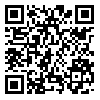BibTeX | RIS | EndNote | Medlars | ProCite | Reference Manager | RefWorks
Send citation to:
URL: http://mjiri.iums.ac.ir/article-1-381-en.html

 , A. Afsharfard
, A. Afsharfard 
 , M. Zeynalzadeh
, M. Zeynalzadeh 
 , A. Najafbeigi
, A. Najafbeigi 
 , P. Yavari
, P. Yavari 
 , M. R. Kalantar Motamedi
, M. R. Kalantar Motamedi 

Abstract
Background: The cosmetic result of the surgical scar has long been considered by surgeons as an important factor for patient satisfaction. On the other hand, there has been an old teaching that perfect closure of contaminated wounds increases the rate of infection. We decided to look into this matter and see if this is a fact or a myth.
Methods: In this prospective randomized study conducted on 200 patients with suppurative or gangrenous appendicitis, we closed the wounds with a cosmetic subcuticular suture of 4/0 nylon in 100 patients and in the other 100 patients the wound was approximated loosely with a few stitches of 3/0 nylon in vertical mattress fashion during a 14-month period.
Results: There was no significant difference in the rate of wound infection between these two groups.
Conclusions: This study shows that perfect closure of the wound with subcuticular closure, which gives a very good cosmetic result in comparison with traditional loose closure, does not increase the rate of wound infection.
| Rights and permissions | |
 |
This work is licensed under a Creative Commons Attribution-NonCommercial 4.0 International License. |



